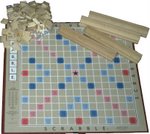 aveled on business to Xi’an, China and Singapore. My first full day in China was on Sunday so I took a tour.
aveled on business to Xi’an, China and Singapore. My first full day in China was on Sunday so I took a tour.I hired a car to take me about 45 minutes outside the city of of Xi’an to view the world famous 2,200-year-old archaeological dig with, the Imperial Terracotta Warriors. The ancient Chinese emperor Qin Shi Huang, in an elaborate attempt to preserve his soul forever, had over 6,000 warriors made of clay and fired in kilns to guard his tomb. All of them were larger than life size (for China anyway), and each with distinctly different features and postures. Figures for archers, generals, and other soldiers were made, facing to the east, west, north and south, guarding the emperor’s tomb. A separate area for headquarters has those figures facing inward; the theory is they are strategizing their next battle. Horses were also made,
 some saddled for the soldiers and some to pull chariots. Bronze arrows, shields, horses and chariots were also buried at the site, as well as other artwork including bronze cranes and other water birds.
some saddled for the soldiers and some to pull chariots. Bronze arrows, shields, horses and chariots were also buried at the site, as well as other artwork including bronze cranes and other water birds. Now the Chinese people are unearthing and painstakingly restoring them. They stand in row upon row in the earthen holes. The original statues had color as well, but the Chinese quickly discovered that once they were unearthed and exposed to the air, the color faded. A display shows what some of them looked like before fading.
Now the Chinese people are unearthing and painstakingly restoring them. They stand in row upon row in the earthen holes. The original statues had color as well, but the Chinese quickly discovered that once they were unearthed and exposed to the air, the color faded. A display shows what some of them looked like before fading.I spent the extra money to hire a Chinese tour guide who spoke E
 nglish, Liu Hong Jun, and he took me through the beautiful gardens with pomegranate and persimmon trees surrounding the site and to view the three separate excavation pits in various stages of restoration. It was a chilly fall day in China and the air was clearer here than in Xi’an itself which has quite a thick and murky atmosphere, the kind that makes your chest hurt a little bit after awhile.
nglish, Liu Hong Jun, and he took me through the beautiful gardens with pomegranate and persimmon trees surrounding the site and to view the three separate excavation pits in various stages of restoration. It was a chilly fall day in China and the air was clearer here than in Xi’an itself which has quite a thick and murky atmosphere, the kind that makes your chest hurt a little bit after awhile.The first pit was found in 1974 by a farmer named Yang who was working in a field. He or a relative still signs books about the museum to this day in the gift shop. My colleagues at work later told me that according to the story, this farmer had to stop signing books for awhile because the flash from the tourist’s cameras had made him temporarily blind; he seemed fine on the day I paid 150 Yuan to buy a book which he signed for free. I leave to the reader the question of whether this was really the original farmer or a surrogate standing in for the day.
My guide told stories of the many measures the emperor had taken, using concepts of Feng Shui, to align his palace and tomb correctly for best good fortune near the mystical Li Mountain. Emperor Qin began the work of his mausoleum when he was 13 years old and it took 38 years, using up to 720,000 conscripts at one point. He had the tomb builders buried alive to ensure that the location of the tomb was kept secret. The Qin Dynasty was a relatively short, cruel one and he was actually emperor of China for only fifteen years. His mausoleum, built of earth and wood with grass mats covering the tomb, was burned by a rival, destroying or damaging many of the relics. Emperor Qin was no friend to Confucians,
 often having them killed. In the end his efforts to live forever were futile. Confucius said:
often having them killed. In the end his efforts to live forever were futile. Confucius said:"All men desire wealth and high status, but if these cannot be achieved in accordance with the moral law, then they should not be accepted. All men hate poverty and low status, but if these cannot be avoided in accordance with the moral law, then they should be accepted. How can anyone who departs from virtue be considered a Chun-Tzu? A Chun-Tzu never departs from virtue, not even for the time of a single meal. When he acts in haste, he acts according to virtue. In times of trouble, he acts according to virtue."



No comments:
Post a Comment